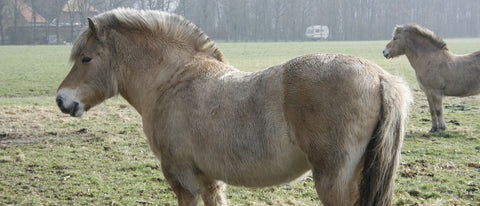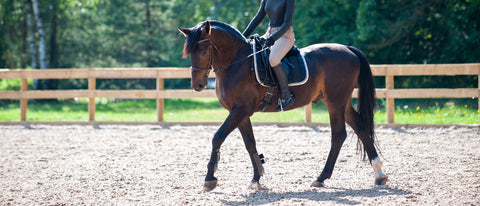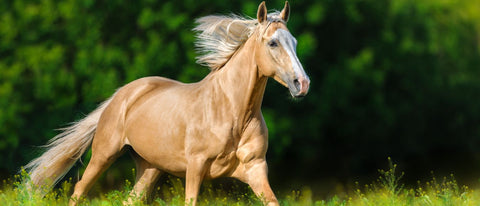
Florian ist aufgewachsen auf einem Bauernhof. Umgeben von Pferden, entdeckte er früh seine Faszination für diese majestätischen Tiere. Inspiriert von seiner reitbegeisterten Mutter, entwickelte er das Nahrungsergänzungmittel - Pferdegold. Seine tiefe Verbundenheit zur Natur und die leidenschaftliche Hingabe zu Pferden trieben ihn an, sein Unternehmen zu gründen.
Carrying fatigue can significantly impair your horse's performance and well-being. It can arise from a variety of causes, such as overwork, unsuitable equipment, or inadequate nutrition. Early detection and targeted treatment are crucial to prevent long-term damage.
Through appropriate training, the right equipment and regular health checks, the risk can be minimized and your horse's health can be sustainably promoted.
What is carrying fatigue in horses?
Carrying fatigue – also known as carrying weakness – refers to a condition in which the horse's back muscles are overstressed. This causes the ribcage to sag between the shoulder blades, which not only impairs the horse's appearance but, more importantly, also its performance.
The cause is often a combination of factors such as
- too intensive or incorrectly coordinated training,
- inadequate preparation of the horse
- or the use of unsuitable equipment.
Some horse breeds, especially warmbloods or horses with long backs, are more susceptible – especially if they are used too early and too intensively.

Perfect for your horse: Pferdegold® supplementary feed!
These specially developed supplements support your horse's diet and provide it with natural nutrients. Made in Germany, grain-free and drug-free, with a 30-day money-back guarantee.
Try it now!Symptoms of carrying fatigue
Horse owners should look out for several signs that indicate carrying fatigue:
Sunken chest
A significantly lowered ribcage is one of the key symptoms. Due to the overloaded muscles, the horse can no longer support the rider optimally, leading to an altered topline.
Exercise concepts that specifically help lift the chest can be helpful here.
Muscle changes
Muscle atrophy is frequently observed in the back and hindquarters . At the same time, the muscles may appear overly tense and stiff . This condition is an indication of chronic overload .
Swayback and other symptoms
A swayback – a visible hollow in the back – is another typical characteristic.
- Stiffness,
- lameness,
- Behavioral changes
- and a reduced appetite may occur.
These symptoms are an expression of disturbed movement patterns.
Effects of carrying exhaustion on the horse’s body
In the long term, the constant strain can lead to significant damage to tendons, ligaments and joints . The continuous muscular overload can lead to secondary diseases such as
- osteoarthritis,
- Late
- or so-called kissing spines may occur.
In addition, important organ functions are impaired because the alignment of the spine is also disturbed.
Diagnosis and treatment of carrying fatigue
A comprehensive veterinary examination is essential for diagnosis . Often, the use of a physiotherapist is recommended, who uses special techniques to relieve muscle tension.
The role of the veterinarian
An experienced veterinarian will examine your horse, perform x-rays if necessary, and develop an individualized treatment plan . Especially with advanced veterinarians, professional assessment is crucial to avoid subsequent health problems.
The importance of physiotherapy
Physiotherapy helps to restore natural mobility and muscle balance .
- Massages,
- Stretching exercises
- and manual therapy supports muscle building and promotes regeneration.

Perfect for your horse: Pferdegold® supplementary feed!
These specially developed supplements support your horse's diet and provide it with natural nutrients. Made in Germany, grain-free and drug-free, with a 30-day money-back guarantee.
Try it now!Further treatment options
In addition to veterinary and physiotherapy treatment , equipment optimization and detailed nutritional analysis can also contribute to a quick recovery.
For example, incorrect saddle fit or inadequate hoof care often lead to overload problems.
The following measures should be taken to reap the benefits:
- Veterinary examination: Enables early detection of health problems and prevents long-term damage.
- Physiotherapy: Promotes mobility and helps reduce pain.
- Adjusting your equipment: Ensures optimal weight distribution and prevents tension.
- Nutritional analysis: Ensures targeted nutrient intake for muscle development and regeneration.
Tips for a strong horse - how to prevent carrying exhaustion
Prevention is key! An effective training and exercise program , coupled with appropriate husbandry and correct riding techniques, can prevent the development of carrying fatigue.
Training and exercise
A customized training program should always be developed gradually. Start slowly to build up the back muscles and only increase the load once your horse has become well accustomed to the new routine.
Regular cross- country riding and special exercises help to prevent swaybacks and improve carrying capacity.
- Cross-country rides
- Special stretching and strengthening exercises
- Gradual conditioning build-up
Equipment and health
The right equipment plays a key role. A suitable saddle and professional hoof care reduce the risk of muscular tension. Regular veterinary checkups and physiotherapy should be part of the routine.
Conclusion
Carrying fatigue is a serious problem, but one that can be managed with proper diagnosis, treatment, and prevention. Early detection, appropriate training, and appropriate equipment are crucial to preventing long-term damage.
FAQ
How does carrying fatigue manifest itself in horses?
Typical symptoms include a sunken chest, muscle atrophy, stiff back muscles, and a swayback. Stiffness and lameness are often also present.
What does carrying exhaustion look like in a horse?
Visually, this can be recognized by an uneven topline, with the chest significantly sunken between the shoulder blades. A swayback is often visible.
How do I train when I'm fatigued?
Focus on gentle, gradual training. Supportive exercises and regular breaks in your training plan are crucial for muscle regeneration.
How long does it take to build back muscles in a horse?
Building up the back muscles can take several months – depending on the type and intensity of training and the individual constitution of your horse.
Why doesn't my horse have any strength in his hindquarters?
A weak hindquarters can be a symptom of carrying fatigue. Causes are often insufficient training, incorrect riding style, or health problems. Targeted strengthening of the back muscles and adapted training programs can help.
🐴 Would you like to read more about health:
















